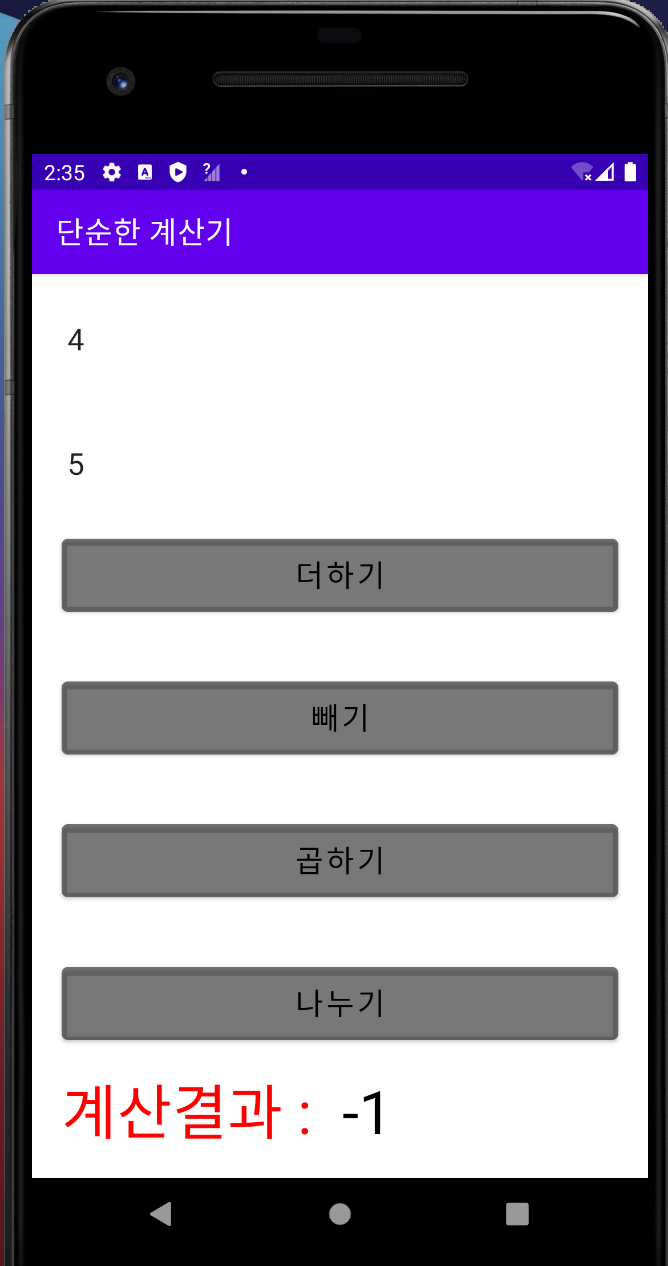<?xml version="1.0" encoding="utf-8"?>
<LinearLayout xmlns:android="http://schemas.android.com/apk/res/android"
xmlns:app="http://schemas.android.com/apk/res-auto"
xmlns:tools="http://schemas.android.com/tools"
android:layout_width="match_parent"
android:layout_height="match_parent"
android:orientation="vertical"
android:padding="10dp"
tools:context=".MainActivity">
<EditText
android:id="@+id/Edit1"
android:layout_height="wrap_content"
android:layout_width="wrap_content"
android:layout_margin="10dp"
android:textSize="20dp"
android:backgroundTint="#ffffff"
android:hint="숫자1"
>
</EditText>
<EditText
android:id="@+id/Edit2"
android:layout_height="wrap_content"
android:layout_width="wrap_content"
android:layout_marginLeft="10dp"
android:layout_marginTop="25dp"
android:textSize="20dp"
android:backgroundTint="#ffffff"
android:hint="숫자2"
>
</EditText>
<Button
android:id="@+id/button1"
android:layout_height="60dp"
android:layout_width="match_parent"
android:layout_marginLeft="10dp"
android:layout_marginRight="10dp"
android:layout_marginTop="20dp"
android:layout_marginBottom="15dp"
android:backgroundTint="#50000000"
android:textColor="@color/black"
android:textSize="20dp"
android:text="더하기"
>
</Button>
<Button
android:id="@+id/button2"
android:layout_height="60dp"
android:layout_width="match_parent"
android:layout_marginLeft="10dp"
android:layout_marginRight="10dp"
android:layout_marginTop="20dp"
android:layout_marginBottom="15dp"
android:backgroundTint="#50000000"
android:textColor="@color/black"
android:textSize="20dp"
android:text="빼기"
>
</Button>
<Button
android:id="@+id/button3"
android:layout_height="60dp"
android:layout_width="match_parent"
android:layout_marginLeft="10dp"
android:layout_marginRight="10dp"
android:layout_marginTop="20dp"
android:layout_marginBottom="15dp"
android:backgroundTint="#50000000"
android:textColor="@color/black"
android:textSize="20dp"
android:text="곱하기"
>
</Button>
<Button
android:id="@+id/button4"
android:layout_height="60dp"
android:layout_width="match_parent"
android:layout_marginLeft="10dp"
android:layout_marginRight="10dp"
android:layout_marginTop="20dp"
android:layout_marginBottom="15dp"
android:backgroundTint="#50000000"
android:textColor="@color/black"
android:textSize="20dp"
android:text="나누기"
>
</Button>
<LinearLayout
android:layout_width="match_parent"
android:layout_height="match_parent"
android:orientation="horizontal"
android:paddingLeft="10dp">
<TextView
android:layout_width="wrap_content"
android:layout_height="wrap_content"
android:textSize="40dp"
android:textColor="#ff0000"
android:text="계산결과 :">
</TextView>
<TextView
android:id="@+id/ans"
android:layout_width="wrap_content"
android:layout_height="wrap_content"
android:layout_marginLeft="20dp"
android:textSize="40dp"
android:textColor="#000000"
android:text="">
</TextView>
</LinearLayout>
</LinearLayout>vertical Layout 안에 horizontal Layout을 넣어서 계산기의 레이아웃을 완성시켰다. Layout을 다루는 것이 많이 익숙해진 거 같다.
추가적으로 배운것이 있다면 textSize로 글자 크기를 testColor로 글자 색깔을 바꿀 수 있다는 것이다.
package com.example.calculatpr;
import androidx.appcompat.app.AppCompatActivity;
import android.annotation.SuppressLint;
import android.os.Bundle;
import android.view.MotionEvent;
import android.view.View;
import android.widget.Button;
import android.widget.EditText;
import android.widget.TextView;
public class MainActivity extends AppCompatActivity {
TextView Edit1,Edit2,ans;
Button button1,button2,button3,button4;
String num1,num2;
Integer result;
@SuppressLint("ClickableViewAccessibility")
@Override
protected void onCreate(Bundle savedInstanceState) {
super.onCreate(savedInstanceState);
setContentView(R.layout.activity_main);
setTitle("단순한 계산기");
Edit1=(EditText)findViewById(R.id.Edit1);
Edit2=(EditText)findViewById(R.id.Edit2);
ans=(TextView) findViewById(R.id.ans);
button1=(Button) findViewById(R.id.button1);
button2=(Button) findViewById(R.id.button2);
button3=(Button) findViewById(R.id.button3);
button4=(Button) findViewById(R.id.button4);
button1.setOnTouchListener(new View.OnTouchListener() {
public boolean onTouch(View arg0, MotionEvent arg1) {
num1=Edit1.getText().toString();
num2=Edit2.getText().toString();
result=Integer.parseInt(num1)+Integer.parseInt(num2);
ans.setText(result.toString());
return false;
}
});
button2.setOnTouchListener(new View.OnTouchListener() {
public boolean onTouch(View arg0, MotionEvent arg1) {
num1=Edit1.getText().toString();
num2=Edit2.getText().toString();
result=Integer.parseInt(num1)-Integer.parseInt(num2);
ans.setText(result.toString());
return false;
}
});
button3.setOnTouchListener(new View.OnTouchListener() {
public boolean onTouch(View arg0, MotionEvent arg1) {
num1=Edit1.getText().toString();
num2=Edit2.getText().toString();
result=Integer.parseInt(num1)*Integer.parseInt(num2);
ans.setText(result.toString());
return false;
}
});
button4.setOnTouchListener(new View.OnTouchListener() {
public boolean onTouch(View arg0, MotionEvent arg1) {
num1=Edit1.getText().toString();
num2=Edit2.getText().toString();
result=Integer.parseInt(num1)/Integer.parseInt(num2);
ans.setText(result.toString());
return false;
}
});
}
}EditText 안에 값은 무조건 String값으로 받아줘야 하는 거 같다.
String 값을 Int로 바꿔주는 명령어는 Integer.parseInt(String)이다.
자바에서 xml의 text 값을 바꿔주는 명령어는 setText(String)이다.
이번에는 눌렀을 때 동작을 OnClickListener가 아니라 OnTouchLitener로 구현하였다.
둘의 차이를 설명하자면 onClickListener는 단순 클릭 이벤트를 받아 이벤트 구현이 가능한 반면,
onTouchListener는
ACTION_UP
ACTION_DOWN
ACTION_MOVE 등 사용자의 손가락 방향, 드래그 등 행동에 맞게 구현, 이벤트 설정이 가능하다.
따라서 계산기를 구현 할 때는 OnClickListener로 구현하는게 더 알맞다.
실행 화면

'안드로이드 > 연습' 카테고리의 다른 글
| [Android] xml RelativeLayout 2 (0) | 2021.08.11 |
|---|---|
| [Android] RelativeLayout 속성 (0) | 2021.08.11 |
| [Android] xml layout_weight (0) | 2021.08.11 |
| [Android] XML 텍스트 색깔 지정 및 위치 조정하기 (0) | 2021.08.10 |
| [Android] 좀 그럴 듯한 앱 (0) | 2021.08.10 |